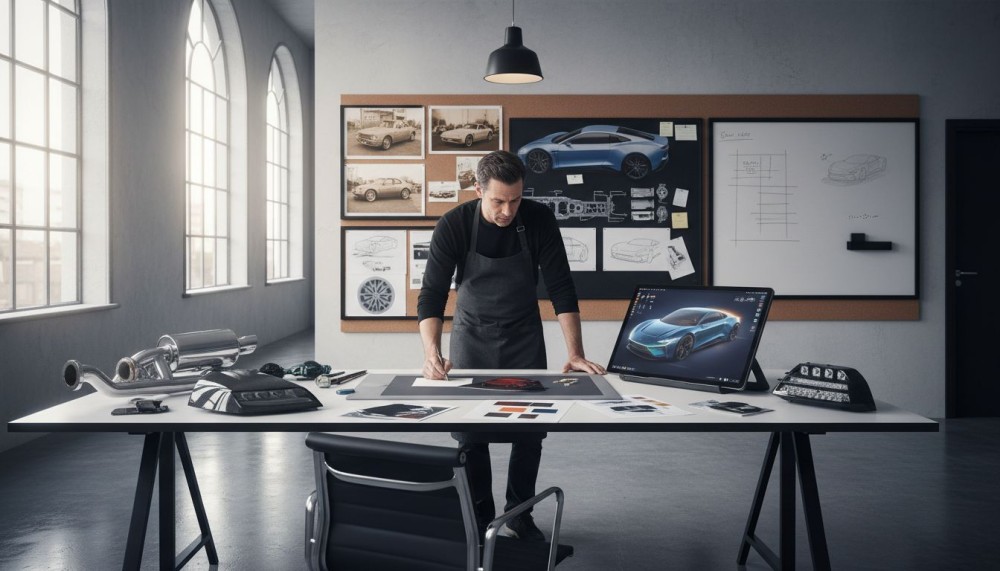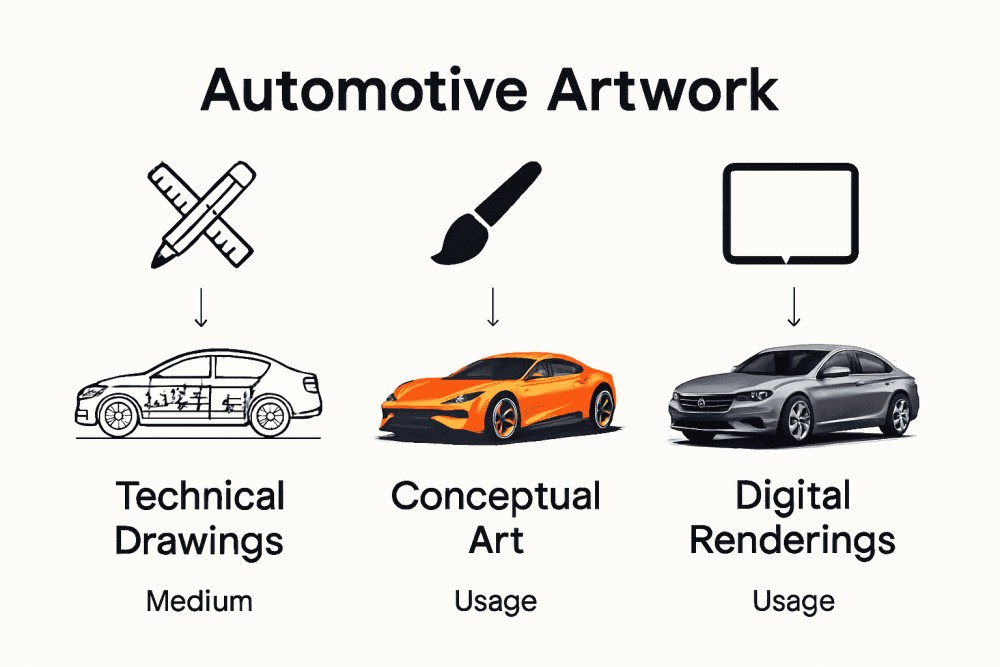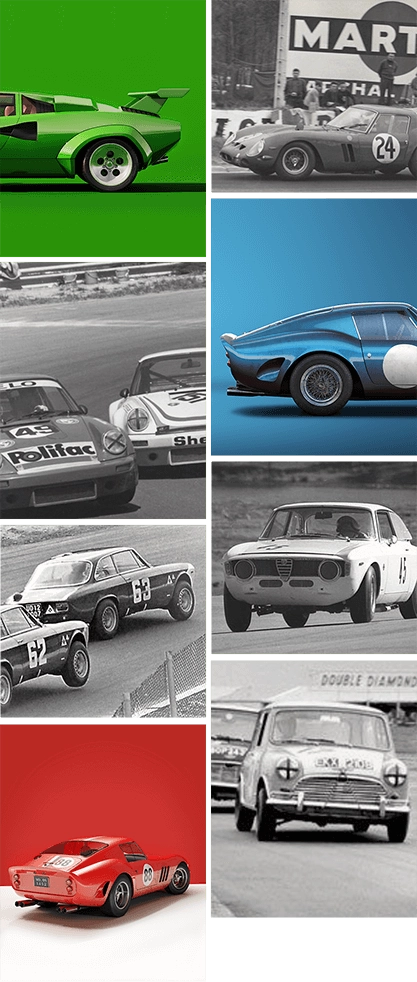Digital rendering has emerged as a particularly powerful medium, allowing artists to create hyper-realistic images that can showcase vehicles in imaginative and impossible scenarios.
Key categories of automotive artwork include:
- Historical documentation illustrations
- Racing and motorsport paintings
- Vintage car portrait studies
- Conceptual design renderings
- Abstract automotive interpretations
- Technical mechanical drawings
As keboto.org highlights, graphic designers play a crucial role in automotive visual representation, collaborating closely with engineers to create compelling visual narratives that significantly influence a car's market appeal. These professionals use advanced techniques like 3D modeling and digital rendering to transform technical specifications into visually stunning artistic expressions.
For automotive art enthusiasts seeking to explore the rich world of vehicle-inspired creativity, our Colors of Motorsport collection offers a curated journey through the most captivating automotive artistic expressions.
Creative Process and Techniques Used
Automotive artists employ a meticulous and deeply technical creative process that transforms initial concepts into breathtaking visual representations. According to courses.diyguru.org, the journey begins with observational sketching, where artists develop an intricate understanding of vehicle shapes, perspectives, and complex geometric forms through careful study and precise drawing techniques.
The initial stages of automotive artwork creation involve multiple critical steps. Artists start with preliminary concept sketches, rapidly exploring different design possibilities and capturing the essence of a vehicle's form. These initial drawings serve as a foundation, allowing artists to experiment with proportion, line weight, and compositional dynamics before committing to a final piece. Digital tools have revolutionized this process, enabling artists to create layered, highly detailed renderings that can be modified and refined with unprecedented precision.
Key techniques in the automotive art creative process include:
- Perspective drawing
- Proportion analysis
- Shading and texture rendering
- Color theory application
- Digital and traditional medium blending
- Ergonomic and structural detailing
Interestingly, scirp.org highlights the critical importance of understanding fundamental design principles, such as determining driver positions (H-Point), which provides artists with crucial insights into the functional and ergonomic aspects of vehicle design. This technical understanding allows automotive artists to create works that are not just visually stunning but also technically accurate and meaningful.
For those passionate about understanding the intricate world of automotive artistry, our Electrifying beauty by Lunaz Design article offers a deep dive into the creative processes behind innovative automotive design.
Influence on Automotive History and Culture
Automotive artists have played a profound role in shaping our collective understanding and perception of vehicles, transforming them from mere mechanical transportation devices into powerful cultural symbols. According to portfolio.newschool.edu, design has been significantly influenced by artistic vision, with designers consistently drawing inspiration from classic cars to create modern vehicles that beautifully blend nostalgic aesthetics with cutting-edge technology.
Through their creative interpretations, automotive artists have documented and celebrated the evolution of transportation design, capturing not just the physical attributes of vehicles but their emotional and cultural significance. Each artwork becomes a historical artifact, preserving the technological innovations, design philosophies, and cultural zeitgeist of different automotive eras. From the sleek streamlined designs of mid-century modern cars to the rugged utility of vintage racing vehicles, these artistic representations tell complex stories about human innovation and aesthetic aspiration.
Key cultural contributions of automotive artists include:
- Documenting technological evolution
- Preserving design heritage
- Capturing emotional connections to vehicles
- Visualizing future transportation concepts
- Celebrating automotive engineering achievements
- Exploring cultural identity through design
As paradigmpress.org highlights, automotive design transcends mere functionality, involving a sophisticated interplay of aesthetics, design principles, and material science. Artists and designers use unique creativity to craft car forms that not only meet visual expectations but also stimulate a profound sense of identity and belonging within automotive culture. Their work becomes a bridge between engineering precision and emotional expression, transforming vehicles from utilitarian objects into powerful cultural statements.
For automotive art enthusiasts eager to explore how design reflects cultural evolution, our A 1968 Porsche 912 motorized by a Model S P85 article offers a fascinating glimpse into the intersection of classic design and modern innovation.
Collaborations, Rights, and Artist Recognition
The world of automotive artistry thrives on dynamic collaborations and intricate professional relationships that bridge creative expression with industrial design. According to jobbank.artsusa.org, automotive artists navigate diverse professional landscapes, working independently, collaborating directly with car manufacturers, and creating commissioned pieces for private collectors while playing a pivotal role in cultural automotive appreciation.
Professional collaborations in automotive art extend far beyond traditional boundaries, creating unique synergies between artistic vision and technical innovation. Artists bring distinctive perspectives that challenge conventional design thinking, introducing fresh aesthetic approaches that can fundamentally transform how vehicles are conceived and perceived. These partnerships often involve complex negotiations around intellectual property, usage rights, and creative attribution, requiring artists to be both creatively flexible and legally sophisticated.
Key aspects of professional collaboration include:
- Negotiating intellectual property rights
- Defining usage and reproduction agreements
- Establishing fair compensation structures
- Protecting artistic integrity
- Creating mutual creative frameworks
- Developing transparent communication channels
As portfolio.newschool.edu highlights, collaborating with contemporary artists enables auto designers to push creative boundaries, resulting in vehicles that are visually striking while maintaining technical efficiency. These collaborations can manifest through custom exterior wraps, immersive interior murals, or conceptual design explorations that challenge traditional automotive aesthetics.




